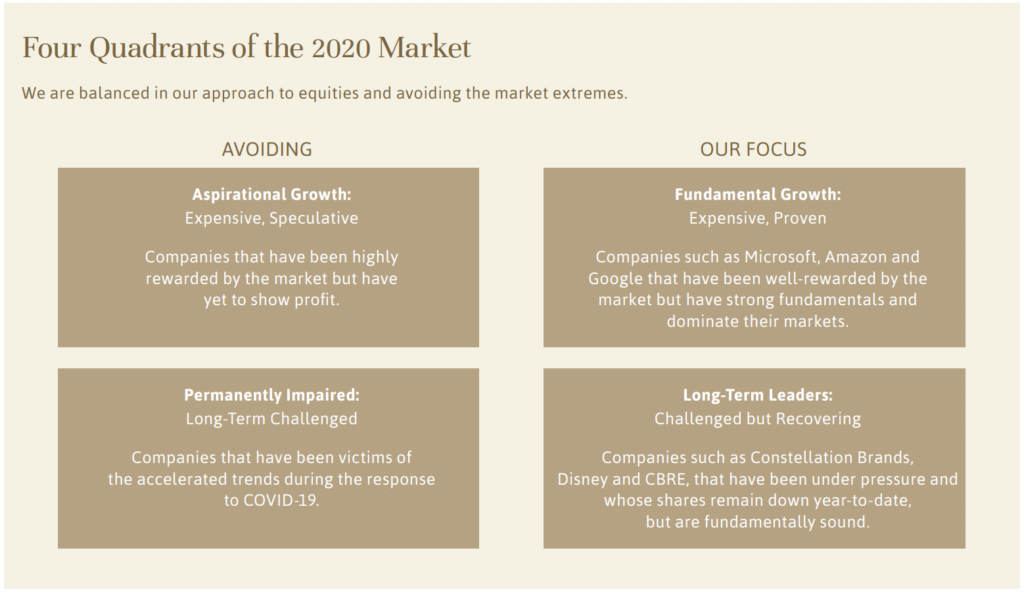
Independent Thinking®
At a Crossroads: Another Way to See the Equity Markets
October 29, 2020
In the previous edition of Independent Thinking, we focused on the role of the large-cap growth stocks in supporting the remarkable market gains since the lows of March. Here’s another way to think about stocks now – in directional quadrants, two of which remain, in our view, best avoided in domestic equity portfolios.
The aspirational sector gets the most investor attention, and its member companies could be said to be having a good pandemic, benefiting from the rapidly accelerating shift to virtual communications and many investors’ assumptions that the long-term growth promise of these companies will eventually be matched with profits and earnings. (These same assumptions are also driving a surge in IPOs; 2020 is on target to be the biggest IPO year since 2000.) There are opportunities in this area but, in our opinion, the best are accessed at early stages through our carefully selected outside venture capital funds. In general, these companies are currently growing the top line with little to no visibility to bottom-line profitability. Indeed, the momentum-driven valuations on many of these stocks is well beyond the comfort level of most fundamental investors. While short-term gains have certainly been realized in many cases, there is little margin for error should growth rates slow or sentiment shift.
Though not quite as dramatic as those of many aspirational sector stocks, many fundamental growth leaders have also recorded big share price gains in 2020. This sector is home to Apple, Alphabet (the parent of Google), Amazon, Facebook and Microsoft, which together represent 25% of the S&P 500, and to a dozen or so smaller domestic growth stocks, including Adobe and Mastercard, also benefiting from accelerating trends. (Evercore Wealth Management includes the stocks named here except Facebook in our core priority list; every client portfolio is customized.) These are alpha, we-can-do anything-you-can-do companies, dominant in their end markets, in their cash flow generation, and in the strength of their balance sheets. And their top-line growth rates are matched by equally impressive bottom lines and consistently strong free cash flows. While valuations have certainly moved up across this quadrant, investors are hard-pressed to find this combination of growth and fundamentals elsewhere.
As our name for the third quadrant suggests, investors may want to avoid most permanently impaired companies. These include Main Street companies, focused on bricks & mortar retail and other deeply impacted sectors, which were already at a disadvantage and have only deteriorated since the arrival of COVID-19. With brick-and-mortar retail leading the way, 2020 may rival the Great Financial Crisis in terms of overall level of bankruptcies. As the uneven economic recovery continues, more companies will probably join them, including those that may currently appear attractive on a pure valuation metric. Investors should not be lured by tempting short-term valuations into adding long-term problems into portfolios. As with companies in the aspirational quadrant, we believe the best way to access opportunistic investments in this sector is through specialized managers, in this case distressed credit funds.
The final quadrant is one where investment opportunity appears most attractive. There are many long-term leaders that have yet to recover from the economic retrenchment of 2020. These companies vary widely, many facing near-term challenges, from high inventory levels after breweries closed due to pandemic restrictions in the case of Constellation Brands, to eventual park and movie theater reopenings in the case of Disney, to necessary technology upgrades by companies like CDW as the workforce returns to offices. As we hold shares of these companies in our discretionary portfolios, our view is that they have the capital structures, cash flows and management confidence to be able to survive this pandemic. In the interim, their stocks have yet to fully recover, providing what we believe to be some combination of prospective fundamental upside and margin of safety in the valuation.

At Evercore Wealth Management, we are focused at present on the long-term leaders quadrant when adding to existing positions and/or introducing new investments to core equity portfolios – and we remain confidently invested in the growth leaders quadrant as well. With very few exceptions, we are avoiding the other two quadrants, although again these categorizations are meant to be directional; there are no bright lines in our approach. Our goal is to build a portfolio of fundamentally strong companies at reasonable valuations. This balance has provided our investors with stability and strong performance through a very volatile period, giving us faith in our approach for the longer term.
Michael Kirkbride is a Managing Director and Portfolio Manager at Evercore Wealth Management. He can be contacted at [email protected].
